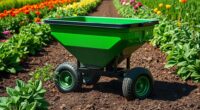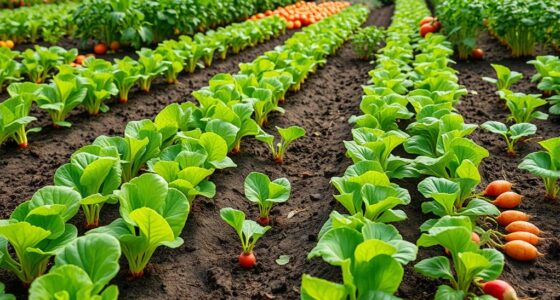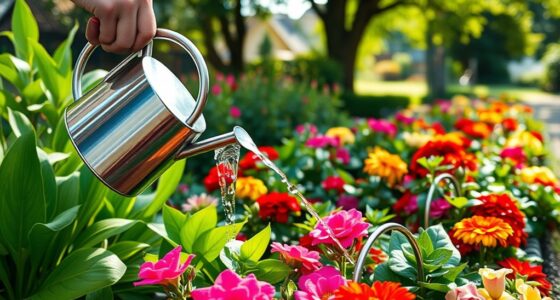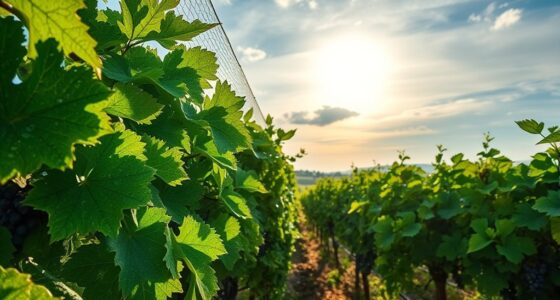To manage olive fruit fly populations in autumn, start by monitoring with yellow sticky traps and inspecting fruit for signs of infestation, like scars or premature ripening. Use cultural practices such as removing fallen fruit and pruning trees to reduce habitat. Biological controls like beneficial insects and fungal treatments can help, along with targeted insecticide applications during peak activity. Continuing with effective strategies will help protect your harvest and minimize future infestations.
Key Takeaways
- Monitor fly activity with yellow sticky traps and visual inspections to identify peak infestation periods.
- Remove fallen, infested, and overripe fruit promptly to reduce breeding sites.
- Apply biological control agents like Beauveria bassiana during adult activity peaks for targeted pest suppression.
- Use baited traps strategically around fruit clusters to catch adults and monitor population trends.
- Prune trees for better airflow, harvest early, and maintain orchard sanitation to disrupt the fly life cycle.
Understanding the Life Cycle of Olive Fruit Flies

To effectively manage olive fruit flies, it’s essential to understand their life cycle. These flies typically begin as eggs laid on or near the olive fruit’s surface. Within a few days, eggs hatch into larvae that burrow into the olives, feeding and causing damage. After feeding, larvae exit the fruit to pupate in the soil, often near the tree’s base. The pupal stage can last from one to three weeks, depending on temperature and conditions. Once adults emerge, they mate and start the cycle again, usually within two to three weeks. Recognizing these stages helps you time interventions effectively, targeting the flies when they are most vulnerable. Understanding their life cycle is key to developing a strategic approach to controlling infestations. Additionally, implementing proper monitoring techniques can help detect early signs of infestation and improve management timing.
Identifying Signs of Infestation in Autumn

As the olive harvest winds down and temperatures drop, signs of olive fruit fly infestations become more noticeable. You might see small dark spots or scars on the fruit, indicating oviposition sites. Look for shriveled or prematurely ripening olives, which can signal larvae activity inside. Damaged fruit often attracts wasps or other insects, adding to the evidence. You may also notice a sticky residue or mold on the fruit surface caused by larval activity and fruit decay. Keep an eye out for fruit falling early or with soft spots, as these are signs of internal damage. Regularly inspect your trees for these symptoms to catch infestations early and prevent further damage. Monitoring infestation signs closely can help prevent widespread damage and reduce the need for chemical controls.
Monitoring Techniques for Detecting Olive Fruit Flies
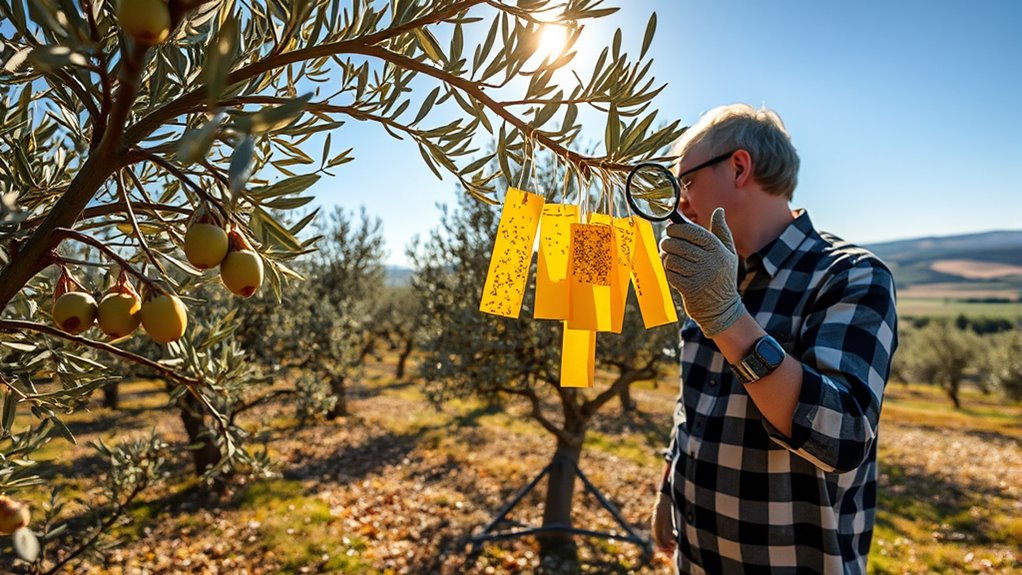
Effective monitoring is essential for detecting olive fruit flies early and preventing significant damage. To do this, use yellow sticky traps placed throughout your orchard, especially near fruiting trees. These traps attract adult flies with their bright color and trap them, helping you gauge population levels. Check traps weekly and record fly counts to identify increasing trends. Additionally, inspect the fruit and surrounding foliage for oviposition sites and larval activity. Combining trap data with visual inspections provides a *thorough* understanding of fly presence. Keep in mind that early detection allows you to implement targeted management strategies promptly. Regular monitoring not only helps prevent widespread infestations but also supports more efficient use of control measures, saving time and resources while protecting your crop. Incorporating integrated pest management techniques can further enhance your ability to manage olive fruit fly populations effectively.
Timing of Pest Management Interventions

Timing your pest management interventions is crucial for controlling olive fruit fly populations effectively. If you act too early or too late, you might miss the window for maximum impact. Monitoring helps identify when the flies are most active, so you can target them precisely. Keep an eye out for adult fly emergence and fruit infestation signs. Intervene when fly activity peaks, typically during warm, dry conditions. Use insecticides or traps at the right time to prevent larvae from developing. Remember, delayed action can lead to increased fruit damage and higher control costs. Proper timing ensures your efforts are efficient and effective, reducing the risk of persistent infestations. Stay alert, and plan your interventions based on ongoing observations and local climate conditions. Cultivating cultural intelligence by understanding local environmental factors can further enhance the timing and effectiveness of your pest management strategies.
Cultural Practices to Reduce Fly Populations
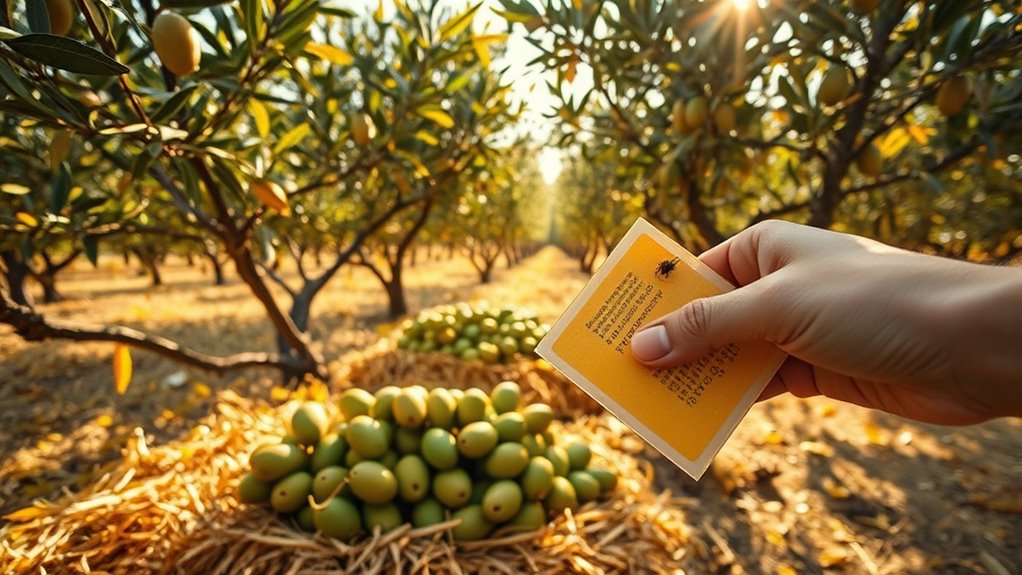
Adjusting harvest timing can help reduce fly populations by removing fruit before it becomes infested. Keeping your orchard clean through regular sanitation and cleanup minimizes breeding sites for the flies. Additionally, planting cover crops offers benefits like attracting natural predators and improving overall orchard health, further suppressing pest numbers.
Harvest Timing Strategies
Harvest timing plays a crucial role in reducing olive fruit fly populations. By carefully planning when you harvest, you can minimize the chances of flies reproducing on your fruit. Early or late harvesting might help you avoid peak fly activity, cutting down on infestations. Monitoring fruit ripeness and fly activity levels allows you to choose the ideal harvest window. Timing your harvest to remove ripe fruit promptly prevents flies from laying eggs. Additionally, coordinated harvests across your orchard can reduce fly populations more effectively. Keep in mind that delayed harvesting might lead to overripe fruit, attracting pests. Balancing perfect fruit maturity with fly activity patterns ensures you protect your crop while reducing the need for chemical controls. Proper timing is a simple yet effective cultural practice to keep your olives healthy. Incorporating seasonal considerations into your harvest planning can further optimize pest management strategies.
Sanitation and Cleanup
Regularly cleaning up fallen and overripe fruit is essential for reducing olive fruit fly populations, as these debris serve as breeding sites for the pests. Remove all damaged or rotting fruit from the ground promptly, and dispose of it away from the orchard to prevent re-infestation. Keep the orchard floor tidy by raking and clearing debris that can harbor larvae or pupae. Pruning and thinning can also reduce hiding spots and improve airflow, making the environment less inviting for flies. Additionally, disinfect tools and containers used in harvest to avoid spreading eggs or larvae. Consistent sanitation disrupts the life cycle of the olive fruit fly, considerably lowering the risk of infestation and protecting your crop. Proper cleanup is a simple yet effective cultural practice in integrated pest management. Incorporating outdoor living and design principles such as maintaining clean, clutter-free spaces can further aid in pest control efforts.
Cover Crops Benefits
Incorporating cover crops into your orchard can considerably reduce olive fruit fly populations by creating a less favorable environment for the pests. Cover crops help disrupt the fly’s life cycle, reduce weeds, and improve soil health. They can also attract beneficial insects that prey on fruit flies or their larvae, enhancing natural pest control. Additionally, cover crops can reduce soil erosion and improve water retention, indirectly supporting healthier olive trees. Choosing the right cover crop species is essential for maximizing benefits. Properly managed, they can serve as a biological barrier, making your orchard less attractive to fruit flies. Overall, cover crops are a sustainable and effective cultural practice to help keep fly populations low and protect your olive harvest. Implementing integrated pest management strategies alongside cover crops can further enhance pest suppression efforts.
Biological Control Options Suitable for Fall
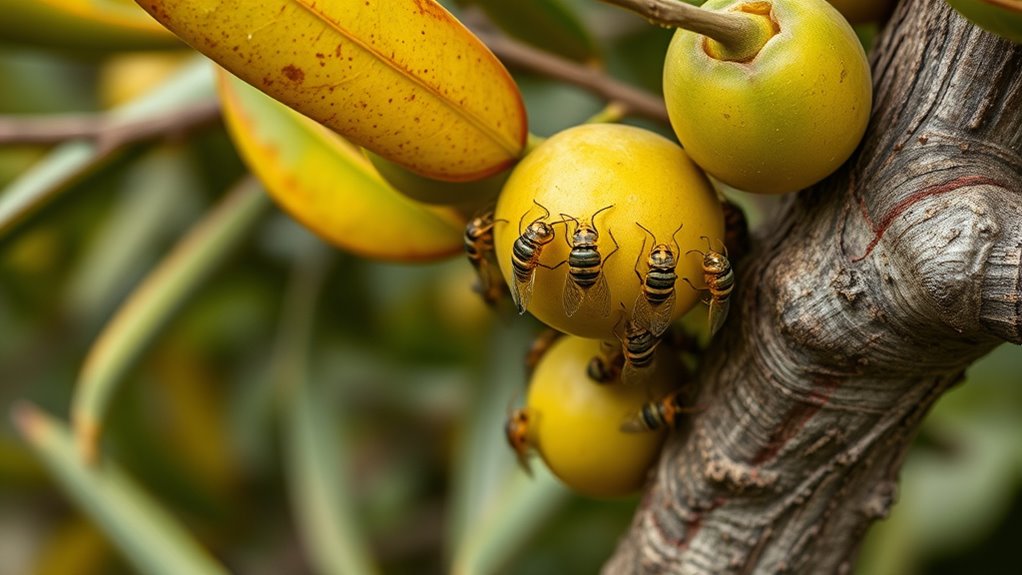
You can enhance fall control by activating natural predators that target olive fruit flies, boosting their populations through habitat management. Using entomopathogenic fungi can also help suppress remaining flies, especially when applied at the right time. Additionally, deploying effective trap strategies can monitor and reduce fly activity during this period. Given the importance of safety and efficacy, ongoing research into AI safety measures supports the development of more effective control methods.
Natural Predators Activation
As fall approaches, activating natural predators becomes an effective biological control strategy against olive fruit fly populations. You can encourage these beneficial insects to thrive and help keep pests in check. To do this, consider planting cover crops that attract predators like parasitic wasps and predatory beetles. Avoid using broad-spectrum insecticides, which can harm these helpful insects. Providing habitat refuges, such as mulch or leaf litter, allows predators to establish and persist. You might also introduce commercially available natural enemies, like specific parasitic wasps, to boost control. Remember, maintaining a healthy orchard ecosystem supports predator populations naturally. Incorporating low light office plants can enhance habitat diversity and support beneficial insect activity. By fostering these beneficial insects, you can reduce pest numbers sustainably and protect your olive crop without relying heavily on chemical controls.
Entomopathogenic Fungi Use
Entomopathogenic fungi offer an effective biological control option for managing olive fruit fly populations during fall. These fungi, such as Beauveria bassiana and Metarhizium anisopliae, infect and kill adult flies upon contact, reducing their numbers naturally. Applying fungal spores during peak activity periods allows you to target the flies directly in their adult stage, decreasing the risk of larval infestation. You should guarantee proper coverage of tree canopies with a suitable formulation, preferably in the early morning or late afternoon when temperatures are ideal. Fungal efficacy depends on environmental conditions and proper application techniques. Fungal treatments are environmentally friendly and can be integrated into your overall pest management plan without harming beneficial insects. Regular applications can help suppress fly populations effectively, supporting sustainable olive production in autumn.
Trap Deployment Strategies
What are the most effective trap deployment strategies for controlling olive fruit fly populations in fall? To maximize trap efficiency, place them where flies are most active, such as near fruit clusters and tree canopies. Use a combination of baited traps with attractants like protein-based lures or pheromones to target different fly behaviors. Regularly check and replace traps to prevent bait degradation and monitor fly activity levels. Position traps at varying heights to cover the entire orchard canopy. Guarantee proper spacing—about 50 meters apart—to avoid trap interference. Keep traps clean and free of debris for ideal attraction. Consider deploying traps early in the season and maintaining consistent monitoring to catch fly outbreaks before they escalate.
- Use multiple trap types for broader coverage
- Place traps in shaded and sunny areas
- Adjust trap height based on fly activity
- Incorporate visual cues to enhance attraction
- Record trap catches for data-driven decisions
The Role of Traps and Baits in Population Management

Traps and baits are essential tools in managing olive fruit fly populations effectively. They help monitor and reduce adult fly numbers, preventing infestations. Proper placement and bait selection maximize their effectiveness, especially in autumn when fly activity peaks. Using attractants like pheromones or food-based lures draws flies into traps, reducing mating and egg-laying. To understand their impact, consider this table:
| Trap Type | Bait Type |
|---|---|
| Sticky traps | Pheromone lures |
| Funnel traps | Food-based attractants |
| Wing traps | Yeast or fermenting fruit |
| Light traps | Light with chemical attractants |
This combination targets flies at different stages, helping you manage the population more effectively during the season’s critical period.
Chemical Control Strategies During Late Season

As the season winds down, chemical control strategies become a vital part of managing olive fruit fly populations. Late-season applications can help reduce the remaining adult flies and prevent further damage. Focus on using targeted insecticides with proven efficacy against olive fruit flies, applying them during the early morning or late evening when flies are most active. Be sure to follow label instructions carefully to guarantee safety and effectiveness. Timing is key—apply treatments before the flies lay eggs or when populations are just starting to decline. Remember, over-reliance on chemicals can lead to resistance, so integrate these methods with other management practices.
- Use selective insecticides to minimize environmental impact
- Apply treatments when adult activity peaks
- Rotate chemical classes to prevent resistance
- Monitor fly populations closely
- Avoid spraying during rain or high winds
Post-Harvest Management and Prevention of Future Infestations

Effective post-harvest management is essential to prevent olive fruit fly populations from rebounding in the next season. After harvest, remove and destroy fallen and infested fruit promptly to eliminate breeding sites. Prune trees to improve airflow and reduce humidity, making the environment less favorable for flies. Harvest ripe olives quickly and efficiently to minimize fruit exposure to infestation. Consider applying targeted insecticides or biological controls on residual fruit or fallen debris, if necessary. Regularly monitor your orchard for signs of reinfestation, using traps or visual inspections. Proper sanitation and timely removal of infested material break the fly’s life cycle, reducing the risk of future outbreaks. Staying vigilant now helps safeguard your crop for the upcoming season and maintains a healthy, productive orchard.
Frequently Asked Questions
How Do Weather Conditions Influence Olive Fruit Fly Activity in Autumn?
Weather conditions substantially influence olive fruit fly activity in autumn. Warmer temperatures speed up their development and increase feeding and breeding. Conversely, cooler weather slows these processes and reduces activity. Sunny days encourage more movement, while rain can suppress fly activity and cause them to seek shelter. You should monitor weather patterns closely, as mild, stable conditions tend to lead to higher fly populations, requiring timely management actions.
Are There Specific Olive Varieties More Resistant to Fall Infestations?
Certain olive varieties act like sturdy shields against fall infestations, naturally resisting olivier invaders. You’ll find that varieties like Arbequina and Frantoio tend to be more resilient, standing firm against fruit fly attacks. By choosing these hardy types, you create a fortress for your orchard, reducing the need for chemical defenses. Embracing resistant varieties is like planting armor on your trees, giving you a fighting chance during autumn’s relentless battle.
What Are the Economic Impacts of Olive Fruit Fly Damage During Autumn?
You face significant economic impacts from olive fruit fly damage in autumn, including reduced yields, lower oil quality, and increased costs for control measures. Damaged olives are often unharvestable or downgraded, leading to financial losses. Plus, frequent treatments raise expenses and can affect your profit margins. Ultimately, unchecked infestations harm your orchard’s productivity and marketability, emphasizing the need for effective management strategies to minimize these economic setbacks.
Can Organic Methods Effectively Control Olive Fruit Flies in Fall?
Yes, organic methods can effectively control olive fruit flies in fall. You can use traps to catch adults, apply natural predators like parasitic wasps, and implement cultural practices such as removing fallen fruit. These strategies target different stages of the fly’s life cycle, reducing populations naturally. By combining these methods, you create an integrated approach that minimizes chemical use, protects your orchard, and promotes sustainable farming.
How Does Harvest Timing Affect Late-Season Fly Populations?
Harvest timing markedly impacts late-season fly populations. If you harvest early, you reduce the fruit’s exposure, limiting fly reproduction. Conversely, delaying harvest can increase infestation risk, as flies lay eggs on ripening fruit. To manage populations effectively, plan your harvest to minimize the window when flies are most active. This approach helps break the fly’s life cycle, reducing infestations and preserving fruit quality throughout the season.
Conclusion
By understanding the olive fruit fly’s life cycle and employing targeted monitoring and control methods, you can effectively manage infestations in autumn. For example, using traps and timely interventions helped a local orchard reduce fly numbers by 60%, ensuring healthier fruit and better yields. Remember, combining cultural practices, biological controls, and precise chemical applications will give you the best results, protecting your olives and preventing future problems. Stay vigilant, and your harvest will benefit.


